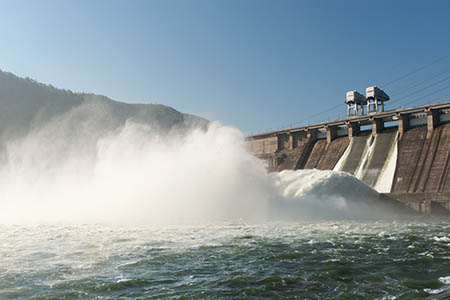Uganda boosts power transmission lines
Source : New Vision
Uganda has boosted high voltage transmission systems, lines and power sub-stations as the country readies to launch new hydro power plants.
Stephen Kyeganwa Mukasa,the principal monitoring and evaluation officer for Uganda Electricity Generation Company Limited (UEGCL), made the revelation during a meeting with the parliamentary committee on natural resources.
He said this will ensure stable, reliable and affordable electricity in Uganda, Rwanda, northern Tanzania, Kenya and eastern DR Congo, stimulating the regional economy.
Mukasa said the construction of the double circuit transmission lines and inter-connection electric grids will improve access to electricity.
The power substations will provide adequate transmission capacity to evacuate power generated at the 600MW Karuma hydro power station.
The legislators, led by Kiboga East MP Dr Keefa Kiwanuka, were on a factfinding mission to assess the status of the transmission lines and the progress of the power sub-stations managed by UETCL in Masaka, Mbarara, Kasese-Hoima and Bundibugyo districts.
Mukasa said the projects are in line with the Government’s Vision 2040 to achieve middle income status.
The Karuma hydro power project is located on the River Nile in Kiryandongo district. When completed, it is expected to generate 600MW.
“The power will be evacuated from six step-up transformers to the national grid through three major transmission lines. These are the 400kV Karuma-Kawanda line (248km), 400kV Karuma- Olwiyo (55km) and 132kV Karuma-Lira line (75km).
They are all undergoing an upgrade to support the 600MW capacity, ” Mukasa told the legislators.
He said the project will also improve electricity access, lower transmission losses, increase power efficiency, reliability, stability and quality of supply countrywide. It is also expected to evacuate power from upcoming solar fields and other power plants.
Other transmission lines under construction include the Mbarara-Mirama-Birembo (Rwanda) 220kV transmission line, Mirama sub-station and Bujagali-Tororo-Lessos 220kV transmission lines.
Others are Kawanda-Masaka 137km double circuit, Masaka-Mbarara 400KV transmission line,Tororo-Opuyo-Lira 132kV transmission line and the Lira-Gulu-Nebbi-Arua 132kV transmission line (314km) grid expansion and reinforcement project.
The expansion and upgrade of power transmission infrastructure, Mukasa said, will help the country meet demand in the West Nile region and northern Uganda.
The others are Bujagali-Tororo-Lessos 220kV transmission lines and associated sub-stations, financed by a loan from the African Development Bank, Japan International Cooperation Agency and the Government.
There is also the Masaka-Mbarara 400kV transmission line and associated substations which were established to boost capacity for grid inter-connection between Uganda and Rwanda.
This project is co-financed by German Development Bank (KfW), French Development Agency and the Government of Uganda.
Mukasa said the Opuyo-Moroto 132kV transmission line (160km) will supply adequate power for the Karamoja sub-region. This project is financed by the Islamic Development Bank.
The Nkenda-Fort Portal-Hoima 220kV power line and sub-station in Kibale will evacuate the power from many hydro power projects in western Uganda.
The projects which are being supervised by the energy ministry and the Government will cost an estimated investment of $1.7b.
Asked how much revenue is expected in exportation of power to other countries and why export it before satisfying the internal demand, Mukasa said: “The colonial masters, before Uganda got independence, had signed agreements committing Uganda to export power to Tanzania, Rwanda and Burundi. On expected revenue, the Cabinet has the agreements and decisions on revenues.”
Kiwanuka said Uganda has capacity to generate much more power as per the agreements signed by UEGCL.
“Uganda has the capacity to generate excess power, and with Karuma, Uganda will have 1500MW. Currently, Ugandans consume 600MW at peak hours. Therefore, the Government has to export the excess energy generated,” Kiwanuka said.
He said the Government made an agreement with UEGCL committing itself to pay for the generated power, whether it is consumed or not. Kiwanuka added that exporting electricity would generate revenues to pay for the production and distribution costs.
“Our generation capacity shall further increase after commissioning the Karuma hydro power project (600MW) whose construction works have progressed to 95%,” Mukasa said.
MPs speak out
Arua Municipality MP Kassiano Wadri wondered who will pay for the project loans and why the Government is focusing on power export rather than managing the load shedding, power blackouts and unavailability of power in northern Uganda.
The Nwoya County MP, Simon Oyet, suggested that the Government should mitigate the devastating effects of COVID-19 on the economy by paying for utilities such as electricity
“I urge the Government to consider a waiver on the payment of electricity bills because many Ugandans have lost jobs due to the closure of companies, rendering them unable to pay for utilities,” he said.
Kashari North MP Wilberforce Yaguma said despite the fact that high voltage power lines pass through his constituency, the people there cannot afford it. The Buyamba County MP, Amos Mandera, lauded the Government for setting up the projects, but expressed concern that the Mbarara-Mirama Hills-Birembo (Rwanda) 220kV transmission line and Mirama sub-station, are behind schedule.
Basemera Kisembo, the Woman MP for Kibaale, said seven out of 14 sub-counties in her district do not have power. She asked the Government to first satisfy internal demand before exporting power to other countries.










 Contact us
Contact us Bookmark page
Bookmark page Email us
Email us
